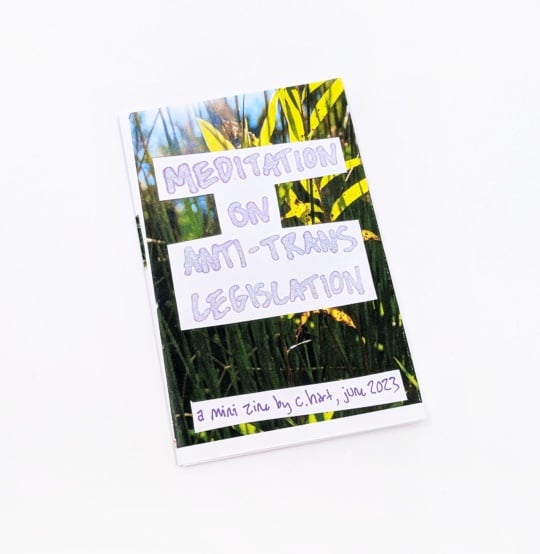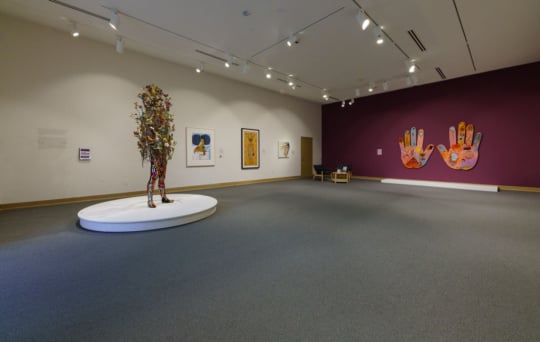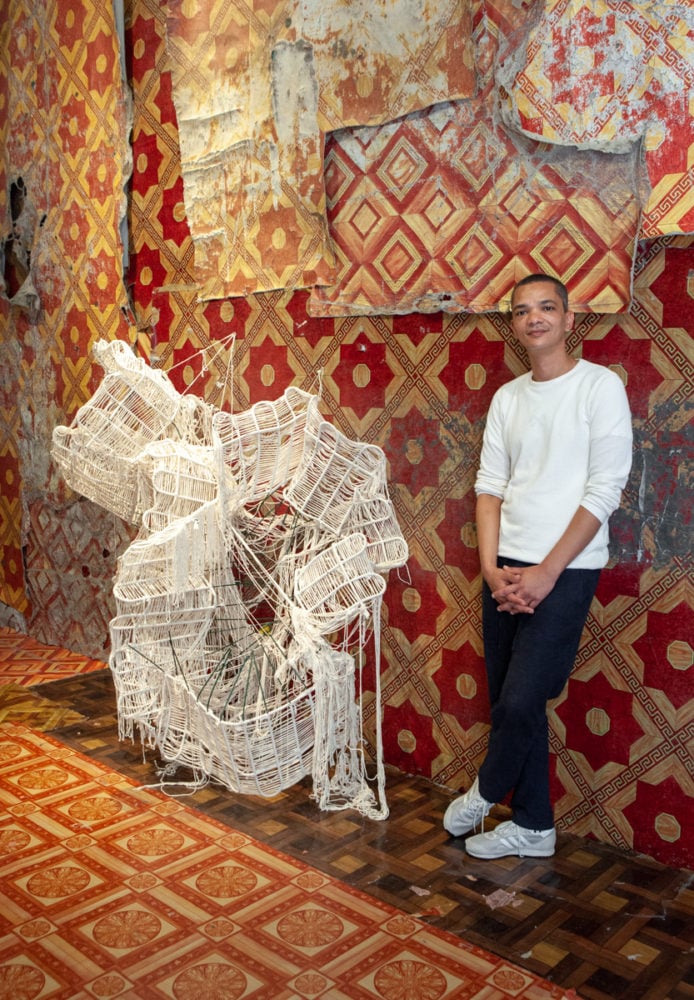
Photograph by Erin Jane Nelson
Igshaan Adams’s (South African, born 1982) first solo museum exhibition in the United States is displayed in a gallery whose walls are built with historic Savannah Grey brick, a masonry style created by enslaved African Americans in the Antebellum South and recalls the region’s violent past. In Getuie (an Afrikaans word that translates into English as “witness”), Adams’ adorned tapestries, fabric wrapped sculptures, and the residue of past performances are displayed along a corridor of battered linoleum floors he sourced from the homes of working class, mixed race communities of his native Cape Town, South Africa. Both the artist and the floors have themselves witnessed the frenetic and violent reality of the racially oppressed communities that endured Apartheid and its residual cultural impacts. Though beautiful, rich, and deeply immersive, Adams’ exhibition comes from a difficult personal history and yearning to heal generational trauma. We spoke in Savannah shortly after the exhibition opened at the SCAD Museum of Art. This conversation has been edited for publication.
Erin Jane Nelson: You mentioned earlier that your mother and aunt helped bead some of your pieces in the exhibition. Do you collaborate with them regularly? How have they influenced your approach?
Igshaan Adams: My family in general has been such a strong influence or inspiration in many cases. As an artist, we all sit with these burning questions, the motivation to know the answer. I wanted to know certain things about myself and so I looked to my family.
I did a performance with my father where he washes and prepares my body as if I had died, which was about creating a moment for the two of us to kind of recenter our relationship; to forgive. Something died in that process, perhaps the younger version of myself that needed to fix the relationship with my father, because I saw him as the monster. He was a drug addict; he was violent. I witnessed my mom being brutally beaten on a daily basis by him. So, I hated him in a sense and I hated myself for being a part of him, coming from him. I knew if I was ever going to have a healthy life, that I needed to fix that. So this performance became that moment of killing the part of me that hated him and opening up a space where we could then renegotiate the relationship and become father and son again, which has happened. We have a fantastic relationship now and it has been good for a long time.
I guess I learned in that process the importance of ritual. So, I created other performances. It works and I wanted to do it again. So, I also did one with my brother. You will see the residue of that performance with my brother in this exhibition with the stool and the bowl. I simply asked my brother to wash my feet and I washed his and again, it was a moment where we could genuinely humble ourselves in front of the other and wash clean the past and what had gone wrong in some points and start fresh. Again, so effective. There’s something about ritual that, as human beings, it just cuts through the bullshit immediately.
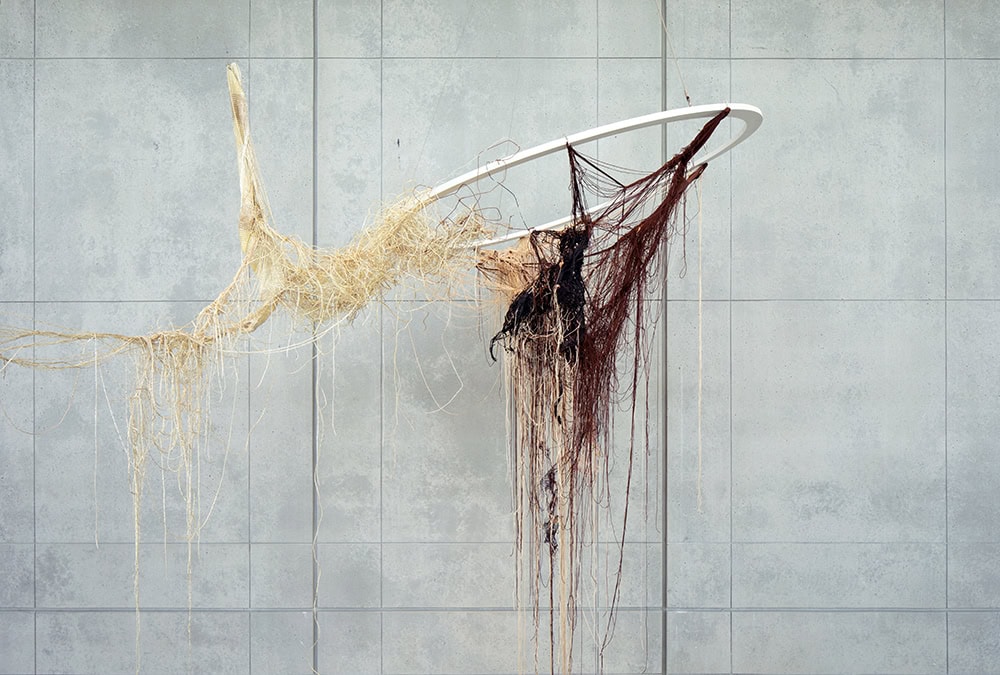
EJN: Do you feel like using ritual is a continuation of a religious practice or do you feel like your religious identity is part of your approach to work?
IA: Yeah. It’s changed over time for sure–it’s a little bit complex. So, I was born Muslim and my father was born Muslim, but my mom was born Christian and she converted at a young age. She really loved Islam and she really put in the effort to understand the religion in her younger years. Ultimately, the abuse really got to her.
EJN: That would shake anyone.
IA: Yeah, 25 years of physical abuse changes you dramatically. So, the religious identity became complex. My maternal grandmother took on the responsibility of raising us when I was five years old because, you know my parents weren’t really responsible. My mother then also became an alcoholic and my father too. They moved away when we were five years old and they moved to a much more dangerous part of the community, the Cape Flats area of Cape Town.
My grandmother was Christian, and a very staunchly religious Christian woman, though I think she loved Islam. She really respected the discipline she saw in other Muslims and she wanted to give us an Islamic education. So she invited an Imam into our home to teach us the Quran and the things about Islam that she couldn’t. She would fast with us during Ramadan because we were kids and there was no one else who could fast with us. But, she still maintained her own religious identity.
EJN: Do you feel like it sticks with you as an adult? Are you still practicing?
IA: Absolutely. I practice very privately. I don’t feel like I belong to any religious community. It’s a very personal thing that I do on my own and the work in the exhibition captures that for me with the two prayer rugs. When it’s just a space for two it’s me and God and nobody else and that’s how I like it; in my bedroom. That’s where my religion remains and nobody else has access to it.
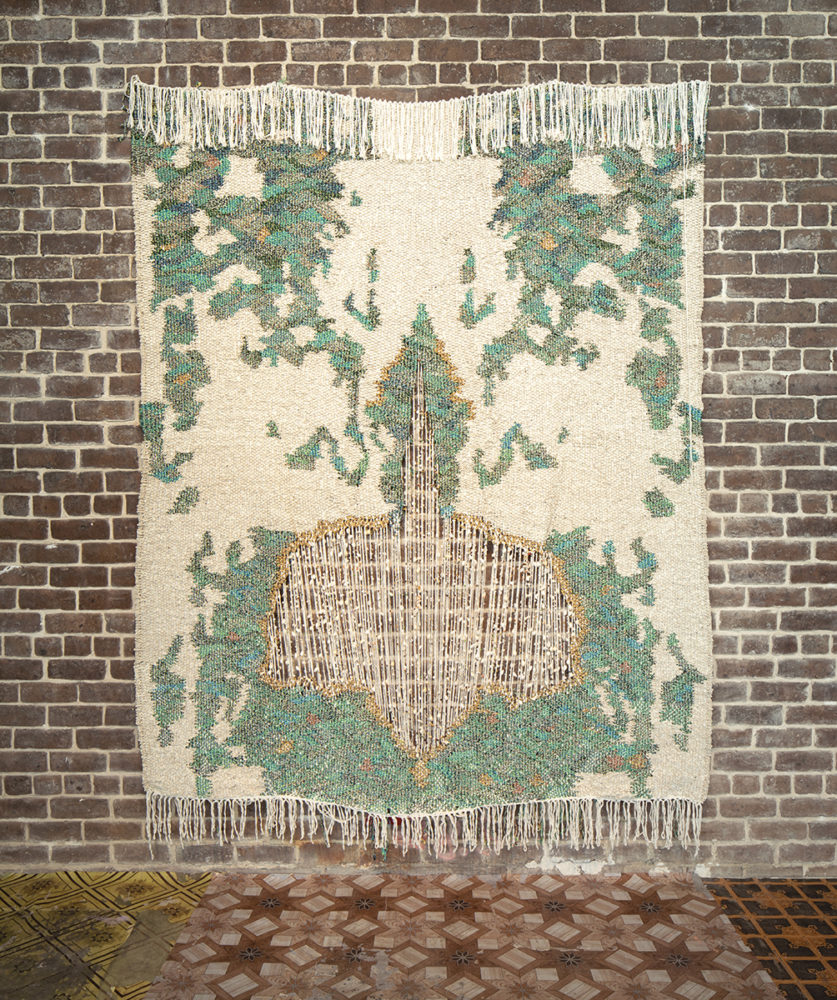
EJN: It strikes me in hearing about the performance with your brother and father, your relationship with your maternal grandmother, collaborating with your mother and aunt after witnessing abuse that your work is deeply tied to families and the domestic. Presenting the weavings, sculptures, and residue of performances among these collected linoleum floors that have so much residue of wear in them, feels very evocative and body-like. I was wondering if you see your practice as trying to break down traditional ideas of masculinity–if it feels radical for you to change the way that men can touch each other and relate to their families?
IA: Absolutely. I think that really came through in the performance with my father because he wasn’t trying to act or get attention. People kept asking him how it was to see his son as a dead corpse wrapped up. He said “well actually he wasn’t dead, so I know he’s not dead. I have a job to do,” so to him it was like washing dishes.
Because in the ritual of washing the dead there is a sequence–first the hands, then the mouth, then the nose–with each touch the history of the relationship pushes through and you can see that. It really came through, that history, without it being forced.
EJN: One of the other things that I’m very curious about in the exhibition is this intrinsic relationship of South Africa and the American South. Between the history of racial violence, gentrification, and the collision of different cultures there are a lot of similarities in recent history. I was wondering if you could describe how it feels for you to present your work for the first time in the United States in Savannah, Georgia and if the relationship between these two parts of the world had any impact on how you approached this body of work?
IA: Absolutely. When Storm Janse van Rensburg asked me to do the exhibition, I specifically chose this body of work and then produced two new works for the show. I chose the work to make that connection, because the linoleum is a universal material. The patterning itself captures motifs that come from across the globe, from Scandinavian to Victorian-inspired to Middle Eastern designs. They all come together in these surfaces, but linoleum also speaks of the working class of the community that I am from, of course and the racial tension between those two communities. I extracted the material from the Colored community and the Black community. And, I know “colored” means something else here but in South Africa it means mixed race, or essentially the community of the emancipated slaves mixed from African, Dutch, the Indigenous Khoisan people of South Africa as well as Indonesian, and Chinese immigrants.
So there is a complete mix within my own community and it was very difficult to classify it because, in America, the separation was basically between white and black. Where I was, it was this in-between race that ranged from completely white-looking to completely black-looking and everything in between. My brother actually was classified at a higher level than myself because, even though we come from the same parents, he had a much lighter skin. He had light green eyes with blondish hair and he was treated as such and I was the opposite so I got treated differently.
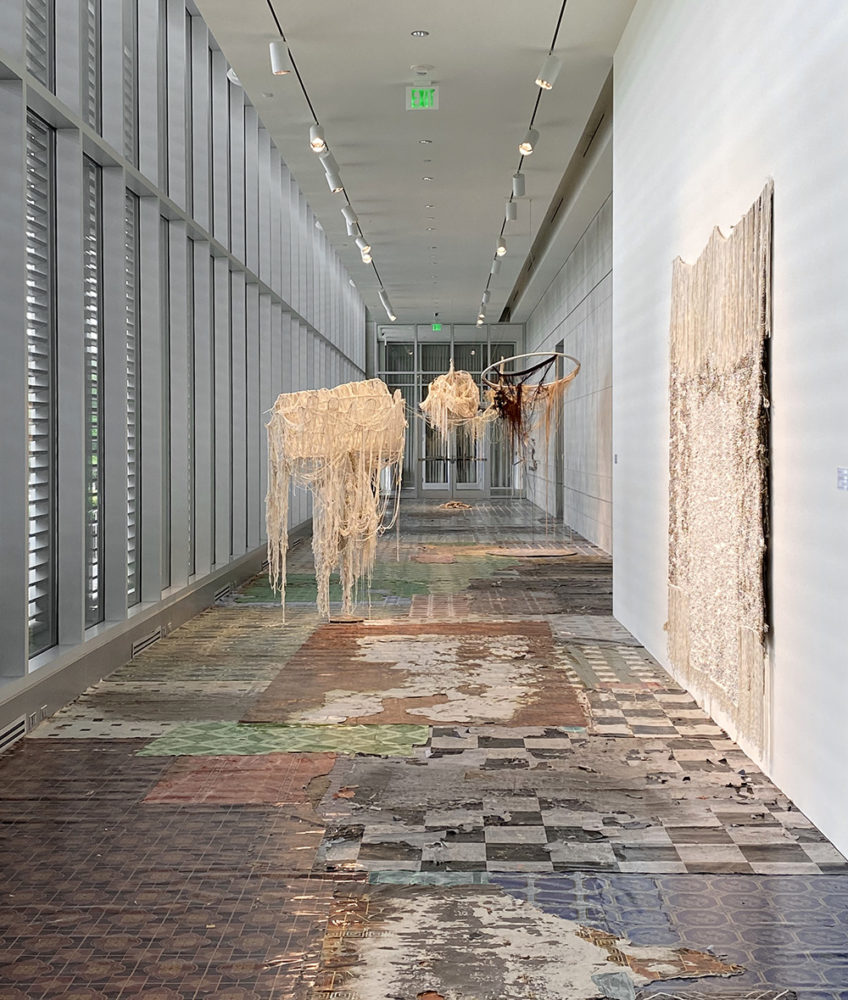
EJN: Those classifications were just implicit? They weren’t official classifications?
IA: No, they were official. My birth certificate states that I am Cape Malay meaning I have Indonesian or Malaysian heritage whereas his says Griqua which is essentially partially white or partially Dutch.
EJN: As brothers, having different official racial classifications seems so… strange.
IA: That tension played out too, because I was essentially overlooked or grew up in his shadow, I would say. I often felt like I had no identity of my own other than being his brother and it was only when I became an artist that I formed my own identity. So, certainly a lot of shared experiences there between the two worlds.
EJN: I was wondering if you were familiar, I mean for me the show evokes something that’s really specific to Savannah, which is the idea of the Southern Gothic. Are you familiar with this?
IA: Someone just spoke about this earlier and it made me think, but no I am not familiar.
EJN: The Southern Gothic is a mostly literary tradition seen in writers like Edgar Allan Poe and Carson McCullers, but it’s essentially this deeply spiritual and symbolic cultural style within the post-confederate south. It spans from Reconstruction through the 20th century and treats both the landscape, people, and cultures of the South as kind of “fractured ghosts.” I was making a lot of those connections walking through your exhibitions.
IA: That sounds very relatable for sure *laughs*
EJN: Savannah is the perfect backdrop of this style because it’s so haunted and there’s so much imagery of the dead and of history here. Obviously, you’re referencing the home, the body, performance, ritual, but I was wondering if there was any cultural or other mediums that you’re interested in, music, film, etc. There seems to be a theatrical bent to the way that you’re presenting the work for example, so I was wondering if there are other mediums that you’re thinking about as you’re making things?
I: Not necessarily. Not consciously anyway. I wouldn’t say that there’s a specific one, like theater or any of those. I do think about the performance of self in everyday life from a spiritual point of view. I consider myself to be constantly performing in this world, playing out this identity in this life experience. I find this quite healthy because it gives me a bit of distance. I am allowed to then look at myself and observe myself.
E: Like catharsis.
I: Yeah, catharsis. I think it’s very healthy because it keeps the focus inward rather than externally in pointing fingers. So in that way, I would say sure performance or performative aspects of identity, but mostly I just love making things. I like taking the wire and turning it into something. I like to keep my hands busy with just forming and making and producing and turning one thing into another. I also quite enjoy the idea of bringing importance to something that would’ve been overlooked or considered valueless. I relate to that idea as a person because I felt a bit devalued, but I had the opportunity to change that. The linoleum for example, is in itself that way. It has no intrinsic value. It has no sentimental value, but by placing it in a museum, it certainly does now. I don’t think people will look at it in the same way after this exhibition.
Igshaan Adams’ exhibition Getuie was presented as part of SCAD deFINE ART and is on view through August 2nd, 2020 at the SCAD Museum of Art in Savannah, Georgia.

